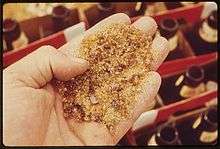Glass recycling

Glass recycling is the processing of waste glass into usable products. Glass waste should be separated by chemical composition, and then, depending on the end use and local processing capabilities, might also have to be separated into different colors. Many recyclers collect different colors of glass separately since glass retains its color after recycling. The most common types used for consumer containers are colorless glass, green glass, and brown/amber glass. Glass is ideal for recycling since none of the material is degraded by normal use.
Glass makes up a large component of household and industrial waste due to its weight and density. The glass component in municipal waste is usually made up of bottles, broken glassware, light bulbs and other items. Adding to this waste is the fact that many manual methods of creating glass objects have a defect rate of around forty percent. Glass recycling uses less energy than manufacturing glass from sand, lime and soda.[1]

(June 1972).
Every metric ton (1,000 kg) of waste glass recycled into new items saves 315 kilograms (694 lb) of carbon dioxide from being released into the atmosphere during the creation of new glass.[2] Glass that is crushed and ready to be remelted is called cullet.[3]
Many collection points have separate bins for clear, green and amber. Glass reprocessors that intend to make glass containers require separation by color, because glass tends to retain its color after recycling. If the recycled glass is intended for other products, or if the glass reprocessor uses newer optical sorting equipment, separation by color at the collection point may not be required. Heat-resistant glass like Pyrex or borosilicate glass should not be disposed of in the glass container as even a single piece of such material will alter the viscosity of the fluid in the furnace at remelt. [4]
Recycling into glass containers
When glass is used for new container manufacturing, it is virtually infinitely recyclable. The processing and use of recycled glass in manufacturing conserves raw materials, and reduces energy consumption. That which is not recycled, but crushed, reduces the volume of waste sent to landfills.[5][4]
Recycling into other products
The use of the recycled glass as aggregate in concrete has become popular in modern times, with large scale research being carried out at Columbia University in New York. This greatly enhances the aesthetic appeal of the concrete. Recent research findings have shown that concrete made with recycled glass aggregates have shown better long term strength and better thermal insulation due to its better thermal properties of the glass aggregates.[6]
Glass aggregate, a mix of colors crushed to a small size, is substituted for pea gravel or crushed rock in many construction and utility projects, saving municipalities like the City of Tumwater, Washington Public Works, thousands of dollars (depending on the size of the project). Glass aggregate is not sharp to handle. In many cases, the state Department of Transportation has specifications for use, size and percentage of quantity for use. Common applications are as pipe bedding—placed around sewer, storm water or drinking water pipes to transfer weight from the surface and protect the pipe. Another common use would be as fill to bring the level of a concrete floor even with a foundation.
Other uses for recycled glass include:
- Fiberglass insulation products
- Ceramic sanitary ware production
- As a flux in brick manufacture
- Astroturf
- Agriculture and landscape applications, such as top dressing, root zone material or golf bunker sand
- Recycled glass countertops
- As water filtration media
- Abrasives
Mixed waste streams may be collected from materials recovery facilities or mechanical biological treatment systems. Some facilities can sort out mixed waste streams into different colours using electro-optical sorting units.
Glass recycling by country
Germany
In 2004, Germany recycled 2,116,000 tons of glass. Reusable glass or plastic (PET) bottles are available for many drinks, especially beer and carbonated water as well as soft drinks (Mehrwegflaschen). The deposit per bottle (Pfand) is €0.08-€0.15, compared to €0.25 for recyclable but not reusable plastic bottles. There is no deposit for glass bottles which do not get refilled.
United Kingdom
Glass collection points, known as Bottle Banks are very common near shopping centres, at civic amenity sites and in local neighborhoods in the United Kingdom. The first Bottle Bank was introduced by Stanley Race CBE, then president of the Glass Manufacturers’ Federation and Ron England in Barnsley on 6 June 1977.[7] Development work was done by the DoE at Warren Springs laboratory, Stevenage, (now AERA at Harwell) and Nazeing Glass Works, Broxboure to prove if a usable glass product could be made from over 90% recycled glass. It was found necessary to use magnets to remove unwanted metal closures in the mix.
Bottle Banks commonly stand beside collection points for other recyclable waste like paper, metals and plastics. Local, municipal waste collectors usually have one central point for all types of waste in which large glass containers are located. There are now over 50,000 bottle banks in the United Kingdom,[8] and 752,000 tons of glass are now recycled annually.[8]
The waste recycling industry in the UK cannot consume all of the recycled container glass that will become available over the coming years, mainly due to the colour imbalance between that which is manufactured and that which is consumed. The UK imports much more green glass in the form of wine bottles than it uses, leading to a surplus amount for recycling.
The resulting surplus of green glass from imported bottles may be exported to producing countries, or used locally in the growing diversity of secondary end uses for recycled glass.[9] As of 2006, Cory Environmental were shipping glass cullet from the UK to Portugal.[10]
United States of America
Rates of recycling and methods of waste collection vary substantially across the United States because laws are written on the state or local level and large municipalities often have their own unique systems. Many cities do curbside recycling, meaning they collect household recyclable waste on a weekly or bi-weekly basis that residents set out in special containers in front of their homes.
Apartment dwellers usually use shared containers that may be collected by the city or by private recycling companies which can have their own recycling rules. In some cases, glass is specifically separated into its own container because broken glass is a hazard to the people who later manually sort the co-mingled recyclables. Sorted recyclables are later sold to companies to be used in the manufacture of new products.
In 1971, the state of Oregon passed a law requiring buyers of carbonated beverages (such as beer and soda) to pay five cents per container as a deposit which would be refunded to anyone who returned the container for recycling. This law has since been copied in nine other states including New York and California. The abbreviations of states with deposit laws are printed on all qualifying bottles and cans. In states with these container deposit laws, most supermarkets automate the deposit refund process by providing machines which will count containers as they are inserted and then print credit vouchers that can be redeemed at the store for the number of containers returned. Small glass bottles (mostly beer) are broken, one-by-one, inside these deposit refund machines as the bottles are inserted. A large, wheeled hopper (very roughly 1.5m by 1.5m by 0.5m) inside the machine collects the broken glass until it can be emptied by an employee.
See also
References
- ↑ "Case history: The truth about recycling". The Economist. 9 June 2007. Retrieved 7 May 2012.
- ↑ "Glass recycling information sheet". wasteonline.org.uk. Retrieved 2006-11-26.
- ↑ "Glass, Common Wastes & Materials". US EPA. Retrieved 22 April 2012.
- 1 2 "First in glass: 10 homegoods for Recycle Glass Month". MNN - Mother Nature Network.
- ↑ British Standards Institute (2005) PAS 101, Recovered container glass, Specification for quality and guidance for good practice in collection
- ↑ K.H. Poutos, A.M. Alani, P.J. Walden, C.M. Sangha. (2008). Relative temperature changes within concrete made with recycled glass aggregate. Construction and Building Materials, Volume 22, Issue 4, Pages 557-565.
- ↑ "Bottle bank celebrates birthday". BBC News. 2007-06-06. Retrieved 2010-05-03.
- 1 2 "Big British bottle bank birthday". reuters.com.
- ↑ British Standards Institute (2005) PAS 102, Specification for processed glass for selected secondary end markets
- ↑ Cory shipping mixed glass to Portugal direct from Cornwall, www.letsrecycle.com. Retrieved 2006-11-28
External links
| Wikimedia Commons has media related to Glass recycling. |
- "Plant Chops Old Bottles For New", August 1949, Popular Science article on the basics of glass recycling
